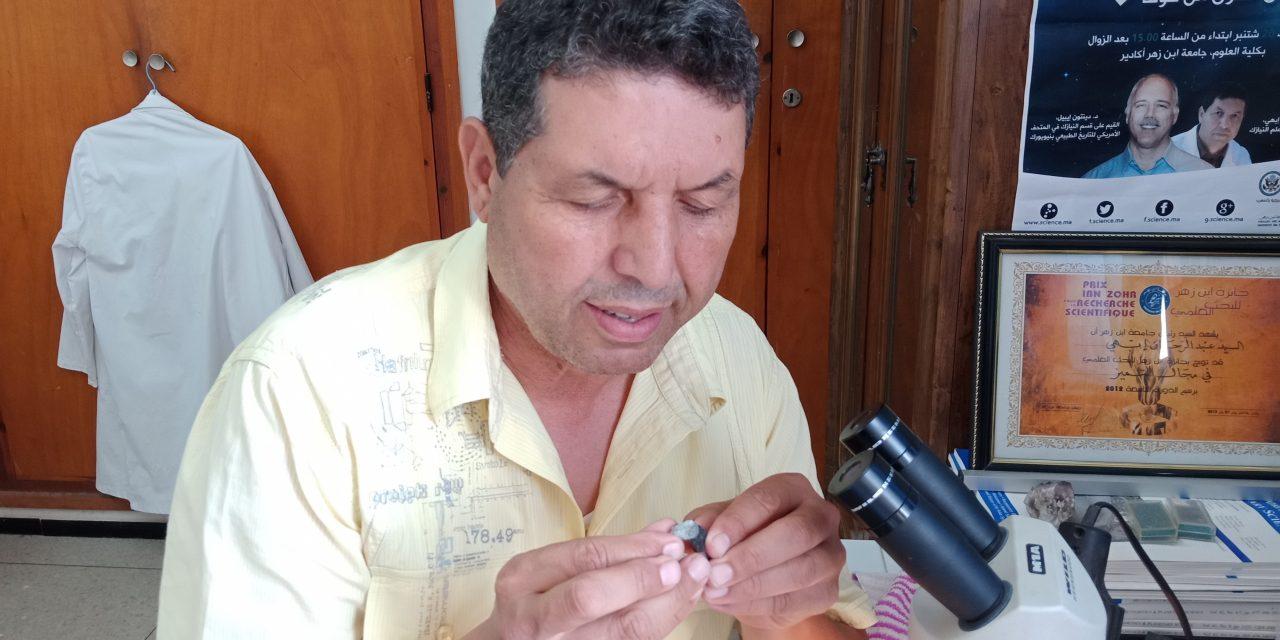Hundreds of meteorite hunters have arrived at the place where the fireball disappeared. They roam the desert in the oppressive heat, on foot or in an off-road car, hoping to find a fragment of this gift that has fallen from the sky.
1 Introduction
A big meteor appeared Thursday, June 27, 2019 at about 17h (local time), at the sky over Morocco (region of the city of Zag, Lhmada region exactly in the rural municipality of Lhtiba). Eyewitnesses of the spectacle of the entry in the Earth’s atmosphere confirm that: “a ball of fire was first orange-blue in color before turning red, illuminating the whole area and breaking into pieces after a large explosion, leaving behind a trail of white smoke”. The fireball was seen by residents of towns and villages more than 150 km from the site of the fall, but its precise speed was not achieved; however, on average, meteorite dropping fireballs move in the atmosphere at a maximum speed of 15 km/s.
2 The meteorite dropping

Figure 1 – The location where the first fragments were found near the rural municipality of Lhtiba.
Thousands of people from surrounding towns and villages have moved to the site. The first fragments of the meteorite were recovered the next day very early in the morning, near the rural municipality of Lhtiba (Figure 1). Most of the found fragments were quickly identified as meteorites because they had a conspicuous melting crust covering part of their surface. The largest mass recorded was about 1300 g, with a total estimated mass of 17 kg. A fragment of the “Lahtiba” meteorite (as it has been tentatively named) about 30 mm in diameter and 20 mm thick was presented to researchers at Ibn Zohr University in Agadir (Figure 2). The measurement of the magnetic sensibility (denoted χm, a dimensionless quantity) on this fragment is of the order of 10.4 and has shown that “Log χ m3 / kg” is of the order of 5.33 with a density of 3.29. The density of chondrites in this meteorite is estimated to be between 4 and 5. These values correspond well to the range of chondrites of the type H4-5 (Folco et al., 2006), thus revealing that it is about an ordinary chondrite from the asteroid belt. It is a sample that did not undergo a large shock (S1–2) and does not represent any degree of terrestrial contamination (W0). Chondrites are the oldest materials in the solar system and are the main source of information for scientists on the conditions of the Sun and planet formation. It is for this reason that they are so interesting to study.

Figure 2 – Professor Abderrahmane Ibhi during the investigation of the June 27 meteorite sample.
Morocco is one of the most important countries in the world for meteorite falls. The supervision on meteorite falls is essentially provided by nomads living and crossing the Moroccan desert all year round. These people are a real network of live cameras. The observations and recovery of these meteorite falls are very interesting for several reasons. The materials from the falls observed have not been submitted to terrestrial contamination, making it a better sample for scientific studies. Southern Morocco is world famous for its meteorites. More than half of the scientific publications on extraterrestrial rocks are made on the basis of Moroccan meteorites. Anyway, the Lhtiba-2019 meteorite of the Zag region is added to the list of meteorite falls in Morocco. Over the past eighty years, twenty-two meteorite falls have been recorded in Morocco, of which nineteen are well-documented. A short list with the names;
- Douar Mghila (1932);
- Oued el Hadjar (1986);
- Zag (1998);
- Itqiy (1990);
- Bensour (2002);
- Oum Dreyga (2003);
- Benguerir (2004);
- Tamdakht (2008);
- Tissint (2011);
- Izrzar (2012);
- Aoussred (2012);
- Oum Drayga (2013);
- Mahbas Arraid, (2013);
- Tighert (2014);
- Tinajdad (2014);
- Sidi Ali Ou Azza (2015);
- Oudiat Sbaa (2016);
- Kheng Ljouad (2017);
- Ksar El Gorrane (2018);
- Geltat zemmour (2018).
Finally, this year Morocco has experienced two meteorite falls. This justifies to consider seriously the creation of a national museum to preserve this heavenly heritage, since Morocco is a country of meteorites. The few Moroccan meteorites that remain in the country are part of some private collections. The largest collection of meteorites in Morocco is owned by the University Museum of Meteorites in Agadir.
Acknowledgments
We are very gratefull to Mr. Bachikh Mouloud (Es Smara), Mr. Bekkar Mohamed (Guelmim), Mr. Leyreloup Christian (Imouzzer Kander), Mr. Amouri Hmad (Erfoud) and Mr. El Jarmouni Mohamed (Casa) for their help in collecting all information and the samples.
References
Luigi Folco, Pierre Rochette, Jérôme Gattacceca, and Natale Perchiazzi (2006). “In situ identification, pairing, and classification of meteorites from Antarctica through magnetic susceptibility measurements”. Meteoritics & planetary science, 41, 343–353.






